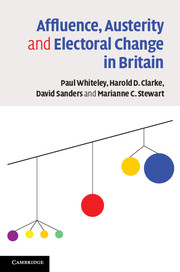Book contents
- Frontmatter
- Contents
- List of Figures
- List of Tables
- Acknowledgments
- 1 The politics of affluence and austerity
- 2 Tony's politics
- 3 Gordon's politics
- 4 ‘I agree with Nick’
- 5 Making political choices
- 6 Bearish Britain
- 7 Choosing how to choose
- 8 Performance politics and subjective well-being
- 9 Valence politics, austerity policies and electoral prospects
- Appendix A Design of the 2010 British election study
- Appendix B Measurement
- Notes
- Bibliography
- Index
4 - ‘I agree with Nick’
Campaigning for change in 2010
Published online by Cambridge University Press: 05 June 2014
- Frontmatter
- Contents
- List of Figures
- List of Tables
- Acknowledgments
- 1 The politics of affluence and austerity
- 2 Tony's politics
- 3 Gordon's politics
- 4 ‘I agree with Nick’
- 5 Making political choices
- 6 Bearish Britain
- 7 Choosing how to choose
- 8 Performance politics and subjective well-being
- 9 Valence politics, austerity policies and electoral prospects
- Appendix A Design of the 2010 British election study
- Appendix B Measurement
- Notes
- Bibliography
- Index
Summary
The timing of the 2010 British general election had a high degree of predictability. When Gordon Brown announced that he would not seek a new mandate in October 2007 following widespread speculation that there would be an early election call, this had two effects. First, it precipitated a rapid erosion of his personal popularity and an end to the public opinion honeymoon which he had enjoyed since taking residence in Number 10 in June 2007. These dynamics were discussed in Chapter 3. But the decision to postpone had a second effect – it informed everyone that the next general election would be delayed until spring 2009 at the earliest and quite likely even longer. In fact, by early 2009, some four years after the previous election, Labour was too far behind in the polls to win, so from that point on it was clear that the next election would be put off until the last possible date – the spring of 2010. This meant that although the official 2010 campaign was a month long as usual, the unofficial ‘long’ campaign which preceded it lasted the best part of a year. From late spring 2009 knowledge that the election would take place a year later permitted the parties to start campaigning early without fear that their efforts would be wasted. As a result, the run-up to the official ‘short’ campaign involved an unusually long unofficial campaign and this helped to shape the outcome.
With this point in mind, the present chapter is divided into four sections. In the first section we describe the official or ‘short’ campaign which lasted from the date the election writs were issued on 6 April to polling day on 6 May. The analysis begins by placing the official campaign in context by describing events earlier in the year which preceded it. Public opinion dynamics during the official campaign are examined using the daily ‘replicate’ surveys conducted in the BES Rolling Campaign Panel Study (RCPS) described in Chapter 1.
- Type
- Chapter
- Information
- Affluence, Austerity and Electoral Change in Britain , pp. 90 - 128Publisher: Cambridge University PressPrint publication year: 2013



